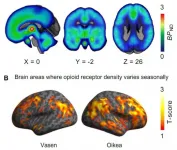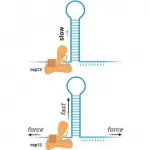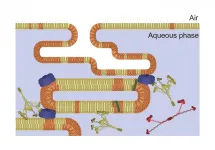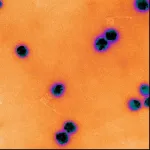New therapeutic target for Huntington's treatment
New perspective on the role of sRNAs in the disease
2021-02-23
(Press-News.org) Huntington's disease is caused by a mutation in the Huntingtin gene (HTT), which appears in adults and features motor, cognitive and psychiatric alterations. The origin of this disease has been associated with the anomalous functioning of the mutated protein: mHTT, but recent data showed the involvement of other molecular mechanisms.
A new study conducted by the University of Barcelona has identified a type of ribonucleic acid (RNA) as a potential therapeutic target for the treatment of the disease. These are the small RNA, or sRNAs, molecules that do not code proteins but have important functions in the regulation of gene expression. According to the study, sRNAs would take part in the development of the disease, results that shed light on the design of new specific drugs to block the activity of these intermediary molecules that help researchers to understand the information in the genes.
The study, published in the journal Acta Neuropathologica, counts on the participation of two teams from the Institute of Neurosciences of the UB, led by the lecturers of the Faculty of Medicine and Health Sciences Eulàlia Martí, also researcher at the Epidemiology and Public Health Networking Biomedical Research Centre (CIBERESP); and Esther Pérez-Navarro, also researcher at the Biomedical Research Networking Center on Neurodegenerative Diseases (CIBERNED) and the August Pi i Sunyer Biomedical Research Institute (IDIBELL), the Center for Genomic Regulation (CRG) and the University Medical Center Göttingen (Germany).
An innovative technique
The objective of the researchers in the study was to understand the toxic potential of the series of sRNAs that are created in the brain of patients with Huntington's disease. The researchers note that the identification of toxicity mechanisms is important to understand how the disease evolves and to design the right drugs and therapeutic strategies.
In order to solve this question, researchers isolated sRNAs from the brain of patients with Huntington's and from people without this disease, to use them as a comparative model. Then, they administrated these molecules in the brain of normal mice and analyse whether the mice developed anomalies similar to those in the human disease. "This is the first time we use a human-origin RNA injection in mice's brain and this innovative strategy enabled us to understand the importance of these molecules independently from the protein", notes Eulàlia Martí.
The results of this experiment show that sRNAs in patients with Huntington's are enough to cause a similar pathology in normal mice, which includes "motor alterations, transcriptional changes similar to those observed in the human disease and mice models, specific affectation of the most affected neuronal type during the course of the disease, neuronal loss and neuroinflammation", says the researcher.
New perspective on the role of sRNAs in the disease
These results suggest a new view on the role of the different types of sRNAs in the progression of the disease. "To date, researchers showed that both the mHTT protein and the RNA that codes it and which has CAG repeats, contribute to neurotoxicity. However, toxic effects related to RNAs with CAG repeats do not explain certain alterations that are important within the context of the pathology, for instance, the specific neuronal affectation or transcriptional alterations. These results -the researcher continues-, show different types of sRNAs created in the patients' brains would be likely to take part in the pathogenesis".
In this sense, the study shows that derived fragments of RNAs, tRNA fragments (tRFs), are the most altered type of sRNAs in the brain of patients with Huntington's. The study shows that a specific tRF can cause neurotoxicity, suggesting that tRFS could participate in the damaging effects related to sRNAs in the affected patients. After this study, the main objective is to understand the functional relevance of different classes of sRNAs, with special emphasis on tRFs that are abundant in affected human brains. "Understanding the dynamics of the expression of toxic classes in brain regions and in the evolution of the disease is crucial to have a full view of their implication in the pathological process", highlights Eulàlia Martí.
Potential biomarkers
Moreover, these molecules could become potential biomarkers of the disease, since there is multiple evidence to show that changes in the RNAs expression occur before the manifestation of the symptoms. Authors say that "these changes can be reflected in biofluids such as plasma and this fact can grant these types a great value as biomarkers".
Last, these results could have implications in the treatment of other diseases. "Alterations in the sRNAs expression are detected early in many neurodegenerative diseases, and therefore, we can find a broader study field to understand what classes can contribute to specific aspects related to neurodegeneration and neuroinflammation", the researcher concludes.
INFORMATION:
[Attachments] See images for this press release:

ELSE PRESS RELEASES FROM THIS DATE:
2021-02-23
X-ray scans revolutionised medical treatments by allowing us to see inside humans without surgery. Similarly, terahertz spectroscopy penetrates graphene films allowing scientists to make detailed maps of their electrical quality, without damaging or contaminating the material. The Graphene Flagship brought together researchers from academia and industry to develop and mature this analytical technique, and now a novel measurement tool for graphene characterisation is ready.
The effort was possible thanks to the collaborative environment enabled by the Graphene Flagship European consortium, with participation by scientists from Graphene Flagship partners DTU, Denmark, IIT, Italy, Aalto University, Finland, AIXTRON, UK, imec, Belgium, Graphenea, Spain, Warsaw ...
2021-02-23
Seasons have an impact on our emotions and social life. Negative emotions are more subdued in the summer, whereas seasonal affective disorder rates peak during the darker winter months. Opioids regulate both mood and sociability in the brain.
In the study conducted at the Turku PET Centre, Finland, researchers compared how the length of daylight hours affected the opioid receptors in humans and rats.
"In the study, we observed that the number of opioid receptors was dependent on the time of the year the brain was imaged. The changes were most prominent in the brain regions that control emotions and sociability. The changes in the opioid receptors caused by the variation in the amount of daylight could be an important factor in seasonal affective disorder," ...
2021-02-23
WASHINGTON -- Researchers have developed a new sensor that could allow practical and low-cost detection of low concentrations of methane gas. Measuring methane emissions and leaks is important to a variety of industries because the gas contributes to global warming and air pollution.
"Agricultural and waste industries emit significant amounts of methane," said Mark Zondlo, leader of the Princeton University research team that developed the sensor. "Detecting methane leaks is also critical to the oil and gas industry for both environmental and economic reasons because natural gas is mainly composed of methane."
In ...
2021-02-23
A new study suggests that a hormone known to prevent weight gain and normalize metabolism can also help maintain healthy muscles in mice. The findings present new possibilities for treating muscle-wasting conditions associated with age, obesity or cancer, according to scientists from the University of Southern California Leonard Davis School of Gerontology.
The research, published this month in the American Journal of Physiology-Endocrinology and Metabolism, addresses the related problems of age and obesity-induced muscle loss, conditions which can lead to increased risk of falls, diabetes and other negative health impacts. It also adds to a growing number of findings describing beneficial effects of MOTS-c, ...
2021-02-23
Scientists at the University of Adelaide have challenged the common assumption that genetic diversity of a species is a key indicator of extinction risk.
Published in the journal PNAS, the scientists demonstrate that there is no simple relationship between genetic diversity and species survival. But, Dr Joao Teixeira and Dr Christian Huber from the University of Adelaide's School of Biological Sciences conclude, the focus shouldn't be on genetic diversity anyway, it should be on habitat protection.
"Nature is being destroyed by humans at a rate never seen before," says computational biologist Dr Huber. "We burn ...
2021-02-23
COLUMBUS, Ohio - Scientists from around the world have published more than 87,000 papers about coronavirus between the start of the COVID-19 pandemic and October 2020, a new analysis shows.
Even given the importance of the pandemic, researchers were surprised by the huge number of studies and other papers that scientists produced on the subject in such a short time.
"It is an astonishing number of publications - it may be unprecedented in the history of science," said Caroline Wagner, co-author of the study and associate professor in the John Glenn College of Public Affairs at The Ohio State University.
"Nearly all of the scientific community around the world turned its attention to this one issue."
Wagner conducted the analysis with Xiaojing Cai from Zhejiang University in ...
2021-02-23
A team of researchers designed and manufactured a new sodium-ion conductor for solid-state sodium-ion batteries that is stable when incorporated into higher-voltage oxide cathodes. This new solid electrolyte could dramatically improve the efficiency and lifespan of this class of batteries. A proof of concept battery built with the new material lasted over 1000 cycles while retaining 89.3% of its capacity--a performance unmatched by other solid-state sodium batteries to date.
Researchers detail their findings in the Feb. 23, 2021 issue of Nature Communications.
Solid state batteries hold the promise of safer, cheaper, and longer lasting batteries. Sodium-ion chemistries are particularly promising because sodium is low-cost and abundant, as opposed ...
2021-02-23
ROCKVILLE, MD - Coronaviruses exploit our cells so they can make copies of themselves inside us. After they enter our cells, they use our cell machinery to make unique tools of their own that help them generate these copies. By understanding the molecular tools that are shared across coronaviruses, there is potential to develop treatments that can not only work in the current COVID-19 pandemic, but in future coronavirus outbreaks as well. Rockefeller University researchers in the labs of Tarun Kapoor and Shixin Liu, including postdoctoral associate ...
2021-02-23
ROCKVILLE, MD - A tenth of all intensive care unit patients worldwide, and many critical patients with COVID-19, have acute respiratory distress syndrome (ARDS). Therapeutic hypothermia, an intentional cooling of the body, has been suggested as a way to improve ARDS. New research by Chiara Autilio and colleagues in the lab of Jesus Perez-Gil at the Complutense University of Madrid shows not only how therapeutic hypothermia works in the lungs at the molecular level, but also why it could be successfully applied to ARDS. Autilio and her colleagues' work was published in Nature Scientific Reports in January 2021 and will be presented ...
2021-02-23
ROCKVILLE, MD - The remarkable genetic scissors called CRISPR/Cas9, the discovery that won the 2020 Nobel Prize in Chemistry, sometimes cut in places that they are not designed to target. Though CRISPR has completely changed the pace of basic research by allowing scientists to quickly edit genetic sequences, it works so fast that it is hard for scientists to see what sometimes goes wrong and figure out how to improve it. Julene Madariaga Marcos, a Humboldt postdoctoral fellow, and colleagues in the lab of Professor Ralf Seidel at Leipzig University in Germany, found a way to analyze the ultra-fast movements of CRISPR enzymes, which will help researchers understand how they recognize their target sequences in hopes of improving the specificity. Madariaga Marcos will present ...
LAST 30 PRESS RELEASES:
[Press-News.org] New therapeutic target for Huntington's treatment
New perspective on the role of sRNAs in the disease







